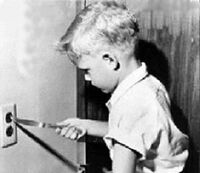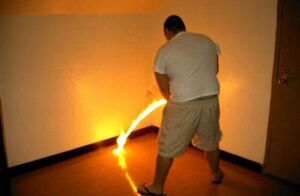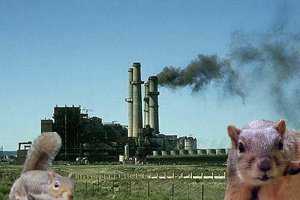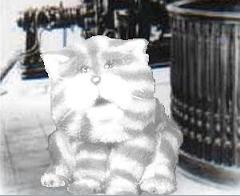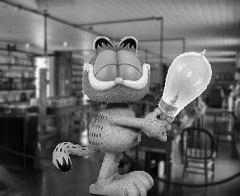Electricity
| This article is part of our series on | |
| Things You Shouldn't Put In Your Mouth | |
|---|---|
| Antimatter | Electricity |
| Laserdiscs | Plutonium |
| Shoes | Chicago |
“The galvanic principle has always galvanized my sense of wonder. Especially when I put my tongue across the poles of a fully-charged Leyden jar.”
Electricity is a scam devised by the famous American plagiarist, Thomas Hernia Edison in the late 19th Century.
It all began in 1769, when tiny gremlin-like creatures called Electrons were discovered to live in metal plates by the joint efforts of Italians Mars Volta and Mario Galvatroni. These "Electrons" could be coaxed to travel down lengths of metal wire (preferring the aroma of copper), performing useful tasks along the way. Alas, the Italians' only interests lay in making the legs of dead frogs move for the amusement of the nobility.
It wasn't until schizophrenic inventor Nikola Tesla realized that these electrons could be used to do so much more that it caught the attention of Edison, who slapped patents on their miniscule backs and put together a company called Consummate Edison, Con Ed for short, which offered to sell electrons. Tesla, meanwhile, was too busy designing death rays and earth-shattering vibrators to notice until it was too late.
The basis of Edison's scam was found in Edison's unique brand of genius: whereas Tesla had the electrons travelling back and forth along a single "live" wire, Edison devised a system of two wires, promoting the additional "neutral" line as being twice as safe and effective, whereby the one could be used for the electrons on their way to the consumer while the other brought them back to Edison's generators. Thus, Con Ed could sell the same electrons to unwitting customers time after time. The reason that no one caught on to this was the incredibly small size of these electrons, which could only be seen by bacteria who themselves needed microscopes.
“We will make electricity so cheap that only the Muslim Mosque will burn candles, and that only for show.”
Edison's scam quickly made him filthy rich, and he was able to spend the rest of his days inventing things like flexible teeth, fur-lined salamanders, and silent radio.
Competition with gasoline
When Edison "discovered" electricity, the western world, particularly the United States, relied on petrochemicals for fuel. People burned gasoline to power their kitchen appliances and air conditioners, and everything from locomotives to lorries used paraffin or diesel oil in their internal conflagration engines.
The US government quickly realized that Edison's new discovery threatened the reign of Big Oil, passed legislation to limit the spread of Edison's invention and favour the petrochemical industry. The politicians objected to large personal fortunes being made from energy unless those fortunes were made by their direct supporters.
In this struggle Big Oil, a massive corporation dedicated to altruistically supporting its employees and customers, provided invaluable support to the US government. Big Oil provided generous funding -- nay, more than generous, superlative-- funding to further this legislation and, as a minor side effect, establishing the US Congress as a club of rich boys. Soon Henry Ford began to produce Automobiles, designed to use only gasoline, and Edison's invisible gremlins were virtually banished from the road.
However, in the home, where the electricity eliminated the smoke and noise of gasoline-powered microwaves, toasters, and blenders, Edison was outselling Big Oil two-to-one.
Negative electrons
Edison initially generated electricity by training the electrons himself, but as demand increased (along with Edison's fortune), he was forced to employ minions to perform this task on his behalf. Unfortunately these minions were less skilled trainers, and the electrons sometimes rebelled against their masters. To make matters worse, Edison had cut costs by feeding the electrons harvested souls. This resulted in very negative electrons that were prone to revolt.
In 1897 the Great Electron Revolt took place, when Edison's huge workforce of electrons attempted to stage a walk-out. However, due to lack of effective leadership and planning in the Electron Union, there was nowhere else for them to go. None of them had homes, families, or athletic clubs. So they milled around aimlessly for awhile, and then started running down the wires in the wrong direction -- the opposite of the direction Edison wanted them to.
Sadly, Edison never regained control of his electrons. To this day, electrons travel out to customers along the "neutral" cable, and return along the "live" cable. The few that try to go the other way are quickly annihilated by their angry brethren.
Electricity originates inside clouds. There, it forms into lightning, which is attracted to the Earth by golfers. After entering the ground, the electricity hardens into coal, which, when dug up by power companies and burned in big ovens called 'generators,' turns back into electricity where it is transformed by TV sets into commercials for beer, which passes through the consumers and back into the ground, thus completing what is known as a 'circuit.'
Reaction with water
If one of Edison's copper wires is placed in contact with water, the electrons get wet and cause all kinds of havoc. The wet electrons run wild, attacking anything that is in the water -- fish, babies, ocean liners, or islands -- with disastrous consequences. This attack, called "electrocution", is much feared by the users of electricity.
Environmental concerns
In the late 20th century the massive worldwide demand for Edison's electrons lead to the construction of "generation plants" all over the world where electrons are convinced to travel into cables. These plants are not nice neighbors, spewing smoke, carcinogens, radiation, smut, mutant squirrels, and other nasty pollutants. It takes a lot of persuasion, publicity spin, and general hot air to get these plants built. This hot air increases global warming, and Big Oil has recently started lobbying the US government for a complete ban on electricity and a return to oil-burning machines which naturally generate much less heat.
Alternative generation
In some laboratory-scale power generation plants hamsters have replaced the electron trainers or "generators" usually used to "generate" electricity. These hamsters do not run in wheels, as some might suppose, but are instead coaxed to fuse and thus release energy. To start a hamster fusion reaction electrons are herded into a large doughnut-shaped mass of copper wires. In the centre of the doughnut is a single hamster. An anti-hamster is then hurled into the doughnut; it collides with the hamster, and both of them disappear in a small puff of green smoke. This strikes fear into the heart of the electrons circling around the doughnut, and they all rush quickly down the nearest wire towards a customer.
However, the worldwide shortage of anti-hamsters and the complex disposal of the small bits of toxic fur that can be left over after the reaction make these reactors problematic. Most electricity is still generated by the "Hot Air" method.
Alignments
No discussion of electricity would be complete if the moral alignments of individual electrons were to be omitted.
Electrons can be labeled as either 'good' or 'bad'. These terms have a conventional meaning to the physicist which is a source of some confusion to the layman; the noisy neighbor's strimmer might be powered by 'good' electricity whereas so-called 'bad' electricity helps to kill golfers and Wizards.
Bad electricity
Bad electricity occurs in nature in the form of balloons, ebonite, nylon and sealing wax. The discovery of bad electricity in cats by Oliver Postgate led to a renaming of the terms, with good electricity being renamed 'bad' and vice-versa. The exact same discovery was made by Thomas Edison; this is now regarded as an example of Morphic Resonance and not considered to be evidence that Edison was a shiny-trousered plagiarist who never had an original idea in his entire life, had a stupid voice and was an anagram of L. Ron Hubbard.
In any event the second discovery led to the terms 'good' and 'bad' being renamed again, with the result that they are now back the way they were before. Edison always claimed that 'his' electricity was somehow 'better' and sought to demonstrate this by electrocuting a hippopotamus called Simon. Postgate pointed out that anyone could electrocute a hippopotamus by, for example, dropping a hair dryer into its mud hole. It was about this time that Edison stopped bathing.
Good electricity
In 1897, J. J. Thompson discovered good electricity in a currant bun in Cambridge and, by 1908, Ernest Rutherford had made a joke about it. The joke will not be repeated here as it is of a somewhat technical nature. By the end of his fourth book on the subject Rutherford's joke was wearing rather thin and after a fifth he was hanged.
As well as being different, the two forms of electricity are one and the same thing. A corollary of this is that each form has the properties of the other or, if you will, both; thus if you rub a balloon on your jumper it will stick to the ceiling to the amusement of all whereas if you rub a cat on your jumper it will savage your gut. Sealing wax is largely neutral in this respect.
Measuring electricity
Equipment needed:
- A wet finger
- A live electrical socket
Method: Place your wet finger into the socket. The louder you cry out in agony, the more powerful the electrical current is. If you die as a result of this experiment, there's obviously a lot of current, and you shouldn't have doubted the amount of power in your home in the first place, you silly person.
Warning! Remember to turn off the electrical socket after finishing this experiment. Leaving an unblocked electrical socket will cause electricity to leak out, eventually filling up the world; resulting in the death of all humans and animals due to electrocution.
Another thing to do to measure electricity is to take a key (maybe the key to your older sibling's car; if you don't have an older sibling who drives, steal an older sibling from somebody else) and go out into a thunderstorm. Hold the key up and let lightning strike it. It's fun to do!!!
Caution! This can be dangerous. It is strongly recommended that you have a couple of drinks to steady your nerves.
See also: other famous scams
- Static electricity
- AM-FM stereo
- Evolution
- Imaginary power
- Radio waves
- Steam engine
- Electricity Gnomes
| Forces of the Universe |
| Gravity | Electricity | War | Mathematics | Sophia | The Flying Spaghetti Monster | Black Metal |
